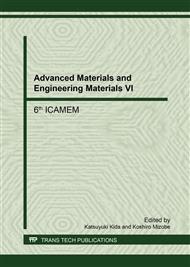p.181
p.187
p.192
p.197
p.202
p.207
p.212
p.218
p.224
Vertical Wall on an Aluminum Alloy Plate Fabricated by Friction Stir Forming
Abstract:
This paper describes utilization of friction-stir forming (FSF) to generate a single wall on an aluminum alloy plate. The proposed process is as follows. The authors placed a material plate on a die having a variable-width groove and conducted friction stirring on its back surface. The material filled the cavity due to high pressure and heat caused by friction stirring. This process can be applied to generate thermal plate-fins and rib structures. The present study investigates the forming conditions and the corresponding results including the height limit of walls to obtain reference data for applications. In the experiment, a 3mm-thick JIS A5083P-O aluminum plate was utilized as the substrate. With a grove of less than 0.2mm-width, the wall was difficult to generate. The maxim height of the 0.2mm-thick wall formed by FSF was 2.8mm, and its aspect ratio was 14, which was difficult to form using conventional forging. Overall, the relationship between groove width of the die cavity and aspect ratio of maximum wall height to wall thickness followed the fractional curvature. This results implies that the deformable material volume generated by friction stirring is a key factor for wall height.
Info:
Periodical:
Pages:
202-206
Citation:
Online since:
August 2017
Authors:
Keywords:
Price:
Сopyright:
© 2017 Trans Tech Publications Ltd. All Rights Reserved
Share:
Citation:


